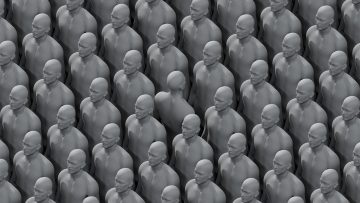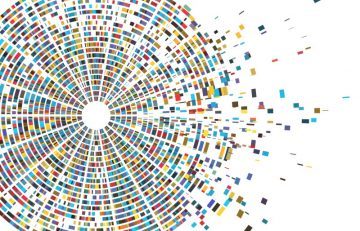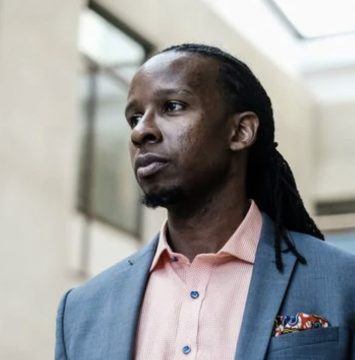Amanda Petrusich at The New Yorker:
 One of my favorite Earle performances is an acoustic cover of Paul Simon’s “Graceland,” which he recorded in 2017 for Hamburger Küchensessions, a German series in which musicians perform from the corner of a kitchen. Take a breath before you watch it. His eyes are fluttering, and he appears unshaven, a little jittery. But his voice is beautiful—fragile and strong. “Graceland” is a kind of American hymn, a song about tragedy and heartache and also the part of a person’s spirit that tells them to keep going anyway, always—to atone and reclaim, as many times as it takes. Earle speeds the song up, and doesn’t quite cling to the melody or the lyrics as Simon wrote them, but his rendition is heavy, spare, and stunning. “I’m going to Graceland,” he promises, over and over as the song ends. It feels good to think that he is there right now, received and at peace.
One of my favorite Earle performances is an acoustic cover of Paul Simon’s “Graceland,” which he recorded in 2017 for Hamburger Küchensessions, a German series in which musicians perform from the corner of a kitchen. Take a breath before you watch it. His eyes are fluttering, and he appears unshaven, a little jittery. But his voice is beautiful—fragile and strong. “Graceland” is a kind of American hymn, a song about tragedy and heartache and also the part of a person’s spirit that tells them to keep going anyway, always—to atone and reclaim, as many times as it takes. Earle speeds the song up, and doesn’t quite cling to the melody or the lyrics as Simon wrote them, but his rendition is heavy, spare, and stunning. “I’m going to Graceland,” he promises, over and over as the song ends. It feels good to think that he is there right now, received and at peace.
more here.
Anne Applebaum in The Atlantic:
 Here is another pair of stories, one that will be more familiar to American readers. Let’s begin this one in the 1980s, when a young Lindsey Graham first served with the Judge Advocate General’s Corps—the military legal service—in the U.S. Air Force. During some of that time, Graham was based in what was then West Germany, on the cutting edge of America’s Cold War efforts. Graham, born and raised in a small town in South Carolina, was devoted to the military: After both of his parents died when he was in his 20s, he got himself and his younger sister through college with the help of an ROTC stipend and then an Air Force salary. He stayed in the Reserves for two decades, even while in the Senate, sometimes journeying to Iraq or Afghanistan to serve as a short-term reserve officer. “The Air Force has been one of the best things that has ever happened to me,” he said in 2015. “It gave me a purpose bigger than myself. It put me in the company of patriots.” Through most of his years in the Senate, Graham, alongside his close friend John McCain, was a spokesperson for a strong military, and for a vision of America as a democratic leader abroad. He also supported a vigorous notion of democracy at home. In his 2014 reelection campaign, he ran as a maverick and a centrist, telling The Atlantic that jousting with the Tea Party was “more fun than any time I’ve been in politics.”
Here is another pair of stories, one that will be more familiar to American readers. Let’s begin this one in the 1980s, when a young Lindsey Graham first served with the Judge Advocate General’s Corps—the military legal service—in the U.S. Air Force. During some of that time, Graham was based in what was then West Germany, on the cutting edge of America’s Cold War efforts. Graham, born and raised in a small town in South Carolina, was devoted to the military: After both of his parents died when he was in his 20s, he got himself and his younger sister through college with the help of an ROTC stipend and then an Air Force salary. He stayed in the Reserves for two decades, even while in the Senate, sometimes journeying to Iraq or Afghanistan to serve as a short-term reserve officer. “The Air Force has been one of the best things that has ever happened to me,” he said in 2015. “It gave me a purpose bigger than myself. It put me in the company of patriots.” Through most of his years in the Senate, Graham, alongside his close friend John McCain, was a spokesperson for a strong military, and for a vision of America as a democratic leader abroad. He also supported a vigorous notion of democracy at home. In his 2014 reelection campaign, he ran as a maverick and a centrist, telling The Atlantic that jousting with the Tea Party was “more fun than any time I’ve been in politics.”
While Graham was doing his tour in West Germany, Mitt Romney became a co-founder and then the president of Bain Capital, a private-equity investment firm. Born in Michigan, Romney worked in Massachusetts during his years at Bain, but he also kept, thanks to his Mormon faith, close ties to Utah. While Graham was a military lawyer, drawing military pay, Romney was acquiring companies, restructuring them, and then selling them. This was a job he excelled at—in 1990, he was asked to run the parent firm, Bain & Company—and in the course of doing so he became very rich. Still, Romney dreamed of a political career, and in 1994 he ran for the Senate in Massachusetts, after changing his political affiliation from independent to Republican. He lost, but in 2002 he ran for governor of Massachusetts as a nonpartisan moderate, and won. In 2007—after a gubernatorial term during which he successfully brought in a form of near-universal health care that became a model for Barack Obama’s Affordable Care Act—he staged his first run for president. After losing the 2008 Republican primary, he won the party’s nomination in 2012, and then lost the general election.
Both Graham and Romney had presidential ambitions; Graham staged his own short-lived presidential campaign in 2015 (justified on the grounds that “the world is falling apart”). Both men were loyal members of the Republican Party, skeptical of the party’s radical and conspiratorial fringe. Both men reacted to the presidential candidacy of Donald Trump with real anger, and no wonder: In different ways, Trump’s values undermined their own. Graham had dedicated his career to an idea of U.S. leadership around the world—whereas Trump was offering an “America First” doctrine that would turn out to mean “me and my friends first.”
More here.
Sydney Perkowitz in Nautilus:
 In January, Robert Williams, an African-American man, was wrongfully arrested due to an inaccurate facial recognition algorithm, a computerized approach that analyzes human faces and identifies them by comparison to database images of known people. He was handcuffed and arrested in front of his family by Detroit police without being told why, then jailed overnight after the police took mugshots, fingerprints, and a DNA sample. The next day, detectives showed Williams a surveillance video image of an African-American man standing in a store that sells watches. It immediately became clear that he was not Williams. Detailing his arrest in the Washington Post, Williams wrote, “The cops looked at each other. I heard one say that ‘the computer must have gotten it wrong.’” Williams learned that in investigating a theft from the store, a facial recognition system had tagged his driver’s license photo as matching the surveillance image. But the next steps, where investigators first confirm the match, then seek more evidence for an arrest, were poorly done and Williams was brought in. He had to spend 30 hours in jail and post a $1,000 bond before he was freed.
In January, Robert Williams, an African-American man, was wrongfully arrested due to an inaccurate facial recognition algorithm, a computerized approach that analyzes human faces and identifies them by comparison to database images of known people. He was handcuffed and arrested in front of his family by Detroit police without being told why, then jailed overnight after the police took mugshots, fingerprints, and a DNA sample. The next day, detectives showed Williams a surveillance video image of an African-American man standing in a store that sells watches. It immediately became clear that he was not Williams. Detailing his arrest in the Washington Post, Williams wrote, “The cops looked at each other. I heard one say that ‘the computer must have gotten it wrong.’” Williams learned that in investigating a theft from the store, a facial recognition system had tagged his driver’s license photo as matching the surveillance image. But the next steps, where investigators first confirm the match, then seek more evidence for an arrest, were poorly done and Williams was brought in. He had to spend 30 hours in jail and post a $1,000 bond before he was freed.
What makes the Williams arrest unique is that it received public attention, reports the American Civil Liberties Union.1 With over 4,000 police departments using facial recognition, it is virtually certain that other people have been wrongly implicated in crimes. In 2019, Amara Majeed, a Brown University student, was falsely identified by facial recognition as a suspect in a terrorist bombing in Sri Lanka. Sri Lankan police retracted the mistake, but not before Majeed received death threats. Even if a person goes free, his or her personal data remains listed among criminal records unless special steps are taken to expunge it.
More here.
Among the pulverised fragments
his father’s chair falls to its knees in prayer,
while the door ululates on a single hinge
and the iron stove cowers in the corner.
Torn curtains flutter in terror,
but only the mirror seems crazed.
Ghost-white, he sits amid
the ash and dust, the collapsed cornices
remembering his old life:
sugar lumps stirred
into a glass of black tea.
Chess with his neighbour,
children’s voices echoing
in the garden where pomegranates
grew outside the high window.
Now, among these ruins, he sits
on his bed, a Turkish pipe
turning his white beard yellow.
It’s the golden oldies from the 50s
he likes the best. Arab songs sung by
Mohamed Dia Eddine, romantic,
and melancholy with his thick black hair.
Slipping the vinyl from its Parlaphone sleeve,
he blows off the dust,
cranks up the windup handle,
closes his eyes as if in prayer,
to picture beneath
this broken wing of sky,
the living dancing the Dabke
through the wounded streets of Aleppo.
by Sue Hubbard
photo by AFP photographer Joseph Eid
Robert B. Talisse in Culturico:
 Democracy imposes a substantial moral burden on citizens. They must regard one another as political equals, even when they disagree deeply about justice. Each side is likely to see the opposition as not only wrong about the issue, but on the side of injustice. How can citizens both stand up for justice and yet embrace a political arrangement that gives injustice an equal say? Political sympathy, a disposition to recognize in our opposition an attempt to live according to their conception of value, is proposed as a way to lighten democracy’s burden.
Democracy imposes a substantial moral burden on citizens. They must regard one another as political equals, even when they disagree deeply about justice. Each side is likely to see the opposition as not only wrong about the issue, but on the side of injustice. How can citizens both stand up for justice and yet embrace a political arrangement that gives injustice an equal say? Political sympathy, a disposition to recognize in our opposition an attempt to live according to their conception of value, is proposed as a way to lighten democracy’s burden.
The frustrations of democracy are familiar. Politicians pander, surrogates spin, opponents object, and citizens pick sides much in the way that they attach themselves to sports teams. Meanwhile, the spectacle of democracy seems to obstruct its point, which is competent and representative government. Careful reflection on the common good tends to get lost amidst the politicking. Yet as citizens we have a responsibility to try to sort through all of the noise so that we can inform ourselves of the issues of the day and exercise our political power wisely. We typically cannot count on our fellow citizens to satisfy this duty. Accordingly, the task of collective self-government exposes us to a great deal of irritation.
What’s more, when our side loses at the polls, democracy’s only consolation is that we may continue working on behalf of our political convictions. We mustn’t resign or withdraw, but instead turn the page and begin anew. Democratic citizenship takes persistence. In both emotional and practical terms, democracy is not only frustrating, it’s also exhausting.
Yet democracy is demanding in another way as well.
More here.
Sean Carroll in Preposterous Universe:
 Human civilization is only a few thousand years old (depending on how we count). So if civilization will ultimately last for millions of years, it could be considered surprising that we’ve found ourselves so early in history. Should we therefore predict that human civilization will probably disappear within a few thousand years? This “Doomsday Argument” shares a family resemblance to ideas used by many professional cosmologists to judge whether a model of the universe is natural or not. Philosopher Nick Bostrom is the world’s expert on these kinds of anthropic arguments. We talk through them, leading to the biggest doozy of them all: the idea that our perceived reality might be a computer simulation being run by enormously more powerful beings.
Human civilization is only a few thousand years old (depending on how we count). So if civilization will ultimately last for millions of years, it could be considered surprising that we’ve found ourselves so early in history. Should we therefore predict that human civilization will probably disappear within a few thousand years? This “Doomsday Argument” shares a family resemblance to ideas used by many professional cosmologists to judge whether a model of the universe is natural or not. Philosopher Nick Bostrom is the world’s expert on these kinds of anthropic arguments. We talk through them, leading to the biggest doozy of them all: the idea that our perceived reality might be a computer simulation being run by enormously more powerful beings.
More here.
Nicole Yeatman in Big Think:
 “One way the internet distorts our picture of ourselves is by feeding the human tendency to overestimate our knowledge of how the world works,” writes philosophy professor Michael Patrick Lynch, author of the book The Internet of Us: Knowing More and Understanding Less in the Age of Big Data, in The Chronicle of Higher Education. “The Internet of Us becomes one big reinforcement mechanism, getting us all the information we are already biased to believe, and encouraging us to regard those in other bubbles as misinformed miscreants. We know it all—the internet tells us so.”
“One way the internet distorts our picture of ourselves is by feeding the human tendency to overestimate our knowledge of how the world works,” writes philosophy professor Michael Patrick Lynch, author of the book The Internet of Us: Knowing More and Understanding Less in the Age of Big Data, in The Chronicle of Higher Education. “The Internet of Us becomes one big reinforcement mechanism, getting us all the information we are already biased to believe, and encouraging us to regard those in other bubbles as misinformed miscreants. We know it all—the internet tells us so.”
In other words, the internet encourages epistemic arrogance—the belief that one knows much more than one does. The internet’s tailored social media feeds and algorithms have herded us into echo chambers where our own views are cheered and opposing views are mocked. Sheltered from serious challenge, celebrated by our chosen mob, we gradually lose the capacity for accurate self-assessment and begin to believe ourselves vastly more knowledgeable than we actually are.
More here.
Matilda Amundsen Bergström at Eurozine:
 At it’s core, temperance means finding, respecting and defending boundaries – especially one’s own. This is sometimes equated with a form of non-action, or as abstention from excess and extremes – especially in relation to bodily pleasures connected to alcohol, food and sex. As a concept, however, temperance offers a much richer array of meanings. Philosopher Alasdair Macintyre, for example, has defined temperance as the choice to not use power which is at one’s disposal. Another possibility is to understand temperance as a practice of dispensation – one which includes being without that which one desires, admitting that every fulfilled desire has consequences, and inquiring into desires and their origins. The latter is an especially significant aspect of the Greek sophrosyne, which could be translated both as temperance and self-knowledge. Yet another alternative is to view temperance as a practice of actively being with others, a form of self-restraint which turns one’s attention away from oneself towards others. From that perspective, many currently popular expressions of self-restraint, such as exercise, dieting or voluntary celibacy, are not temperate since they are motivated by the individual’s own desires. Neither do enforced limitations such as laws banning smoking or drugs have anything to do with temperance, since the virtue involves the choice to act in a certain way as much as the action itself – acknowledging the boundary as well as adhering to it.
At it’s core, temperance means finding, respecting and defending boundaries – especially one’s own. This is sometimes equated with a form of non-action, or as abstention from excess and extremes – especially in relation to bodily pleasures connected to alcohol, food and sex. As a concept, however, temperance offers a much richer array of meanings. Philosopher Alasdair Macintyre, for example, has defined temperance as the choice to not use power which is at one’s disposal. Another possibility is to understand temperance as a practice of dispensation – one which includes being without that which one desires, admitting that every fulfilled desire has consequences, and inquiring into desires and their origins. The latter is an especially significant aspect of the Greek sophrosyne, which could be translated both as temperance and self-knowledge. Yet another alternative is to view temperance as a practice of actively being with others, a form of self-restraint which turns one’s attention away from oneself towards others. From that perspective, many currently popular expressions of self-restraint, such as exercise, dieting or voluntary celibacy, are not temperate since they are motivated by the individual’s own desires. Neither do enforced limitations such as laws banning smoking or drugs have anything to do with temperance, since the virtue involves the choice to act in a certain way as much as the action itself – acknowledging the boundary as well as adhering to it.
more here.
Hannah Ewens at The Paris Review:

Waiting outside venues has been an integral part of the fangirl experience and something of an embodiment of their lifestyle from the very beginning. Columbus Day, New York City, 1944, a Frank Sinatra show, and the New York photojournalist Weegee was there when the first of the pop stars as we know them was about to take to the stage. “The line in front of the Paramount Theatre on Broadway starts forming at midnight,” he recalled. “By four in the morning, there are over 500 girls … They wear bobby sox (of course), bow ties (the same as Frankie wears) and have photos of Sinatra pinned to their dresses.” The three-thousand-seat house was quickly filled with girls waiting to see Sinatra for the first of his scheduled performances of that day. Apparently inside the theater the ammoniac smell of pee was heavy in the air because girls refused to leave their seats for food, water, anything, unless they were physically moved by attendants. Over the duration of the day, a riot bubbled over outside where, according to records, police had to deal with thirty to thirty-five thousand young female Sinatra fans, lining the streets around the theater, calling out to be let in.
more here.
Ashish Ghadiali in The Guardian:
 There’s a trope of the British Asian identity narrative, once captured with such originality and brilliance in Hanif Kureishi’s Buddha of Suburbia and much replicated – in Monica Ali’s Brick Lane, for example, or Ayub Khan-Din’s East Is East – that now fills most British Asians of my generation (I’m 40) with dread. It’s the one about the second-generation immigrant held back by the ignorance of parents or a community that’s either comically absurd or violently fundamentalist. Against this backdrop, the second-generation hero or heroine emerges once they find the strength to stand apart from this reactionary past and assimilate into the mainstream of British life.
There’s a trope of the British Asian identity narrative, once captured with such originality and brilliance in Hanif Kureishi’s Buddha of Suburbia and much replicated – in Monica Ali’s Brick Lane, for example, or Ayub Khan-Din’s East Is East – that now fills most British Asians of my generation (I’m 40) with dread. It’s the one about the second-generation immigrant held back by the ignorance of parents or a community that’s either comically absurd or violently fundamentalist. Against this backdrop, the second-generation hero or heroine emerges once they find the strength to stand apart from this reactionary past and assimilate into the mainstream of British life.
This narrative certainly had its time, but we have come to dread it, because through it we dehumanise ourselves and demean the journeys that have made us who we are. It’s also a lie, since no degree of immigrant assimilation can overturn the racism that is systemic in British life, and that our mainstream culture has the habit of perpetuating.
For me, the potted biography on the dust jacket of Mohsin Zaidi’s book (subtitled A Memoir of a Gay Muslim’s Journey to Acceptance) was enough to provoke the first stirrings of that familiar sense of foreboding. Here we learn that the author, raised in a “devout Muslim community”, was the “first person from his school to go to Oxford University” before going on to become, an accomplished criminal barrister, a board member of Stonewall, the UK’s biggest LGBT rights charity, and a governor of his former school in east London. It’s only a blurb, but there is a subtly Islamophobic framing here that opposes Zaidi’s “devout Muslim” background with the progressive attainment of his life and career.
More here.
From Nature Research:
 With the refinement and reduced cost of sequencing technology, science has reached another inflection point: population-scale genomics, where clinical-grade assays can be used to advance healthcare, while fueling research. The Healthy Nevada Project (HNP) epitomizes that movement. A population health initiative run by the Renown Institute for Health Innovation (Renown IHI), a partnership between Renown Health and the Desert Research Institute, the project aims to combine genomic, environmental and medical data from 250,000 participants to assess the influence of genetics on health and disease. The study also uses sequencing data to screen participants for medically actionable genetic conditions, such as familial hypercholesterolemia (FH), hereditary breast and ovarian cancer syndrome (HBOC), and Lynch syndrome (LS).
With the refinement and reduced cost of sequencing technology, science has reached another inflection point: population-scale genomics, where clinical-grade assays can be used to advance healthcare, while fueling research. The Healthy Nevada Project (HNP) epitomizes that movement. A population health initiative run by the Renown Institute for Health Innovation (Renown IHI), a partnership between Renown Health and the Desert Research Institute, the project aims to combine genomic, environmental and medical data from 250,000 participants to assess the influence of genetics on health and disease. The study also uses sequencing data to screen participants for medically actionable genetic conditions, such as familial hypercholesterolemia (FH), hereditary breast and ovarian cancer syndrome (HBOC), and Lynch syndrome (LS).
…In July, Helix and the HNP team reported findings from the first 27,000 participants in an article published in Nature Medicine1. Among HNP participants, the researchers found that approximately 1 in 75 carried a variant predisposing them to HBOC, LS, or FH. Of those predisposed, nearly 22 percent had already begun to develop symptoms of disease. Importantly, 90 percent of those with medically actionable results would not have known about their increased risks for disease had they not participated in the study; patients often don’t qualify for genetic screening under current clinical guidelines.
More here.
I’m ordered to a big hump of stones
as if I were an aristocratic corpse from the Iron Age.
The rest are still back in the tent sleeping,
stretched out like spokes in a wheel.
In the tent the stove is boss: it is a big snake
that swallows a ball of fire and hisses.
But it is silent out here in the spring night
among chill stones waiting for the dawn.
Out here in the cold I start to fly
like a shaman, straight to her body–
some places pale from her swimming suit.
The sun shone right on us. The moss was hot.
I brush along the side of warm moments,
but I can’t stay there long.
I’m whistled back through space–
I crawl among the stones. Back to here and now.
Task: to be where I am.
Even when I’m in this solemn and absurd
role: I am still the place
where creation works on itself.
Dawn comes, the sparse tree trunks
take on color now, the frostbitten
forest flowers form a silent search party
after something that has disappeared in the dark.
But to be where i am . . . and to wait.
I am full of anxiety, obstinate, confused.
Things not yet happened are already here!
I feel that. They’re just out there:
a murmuring mass outside the barrier.
They can only slip in one by one.
They want to slip in. Why? They do
one by one. I am the turnstile.
by Tomas Tranströmer
trans. Robert Bly
Justin E. H. Smith at his own blog:

I recently published a short piece on cultural appropriation in Persuasion. Some of my fears about its reception quickly came true. Within hours of its posting, I had the singular misfortune of being linked approvingly by the odious cornball Ben Shapiro. In no time at all I was being followed by all manner of know-nothing right-wing riff-raff, people I do not respect and do not at all wish to affirm in their flimsy little construction of a belief system. This made me think it would be worthwhile to dilate somewhat more longwindedly on the topic here, in the hope of making it clear to those people the many respects in which I am not one of them, and also in the aim of reflecting a bit on how it is that we have arrived at this strange conjuncture, where defense of cultural appropriation is interpreted as a right-wing talking point, and on why I still believe it is essential to win it back from them.
I’ll say in passing, before getting to the main part of my reflection, that in part I blame the structures of information-flow, in which we are all forced to (pretend to) communicate today, for the automatic channeling of this topic to the side of the right. The algorithms on which the social-media parody of a public sphere operate are dichotomous in nature, and every statement has to be channeled in the one direction or the other. You can fight against these structural constraints, speaking your mind as your conscience dictates, etc., but all the forces are against you. Persuasion is itself an effort to defy the dichotomy, and so far, from what I have seen, it is maintaining a rather delicate balancing act. As for me, I find that my conscience comes through most clearly when I am writing on my own website— but this is only because it stands somewhat further apart from the structures that support all media interventions in the proper sense. Which is to say that the only way for me to say what I really mean, and not to be misunderstood, is to accept that I will be read by far fewer people.
More here.
From Phys.org:
 A group of theoretical physicists, including two physicists from the University of Groningen, have proposed a ‘table-top’ device that could measure gravity waves. However, their actual aim is to answer one of the biggest questions in physics: is gravity a quantum phenomenon? The key element for the device is the quantum superposition of large objects. Their design was published in New Journal of Physics on 6 August.
A group of theoretical physicists, including two physicists from the University of Groningen, have proposed a ‘table-top’ device that could measure gravity waves. However, their actual aim is to answer one of the biggest questions in physics: is gravity a quantum phenomenon? The key element for the device is the quantum superposition of large objects. Their design was published in New Journal of Physics on 6 August.
Already in the preprint stage, the paper that was written by Ryan J. Marshman, Peter F. Barker and Sougato Bose (University College London, UK), Gavin W. Morley (University of Warwick, UK) and Anupam Mazumdar and Steven Hoekstra (University of Groningen, the Netherlands) was hailed as a new method to measure gravity waves. Instead of the current kilometers-sized LIGO and VIRGO detectors, the physicists working in the UK and in the Netherlands proposed a table-top detector. This device would be sensitive to lower frequencies than the current detectors and it would be easy to point them to specific parts of the sky—in contrast, the current detectors only see a fixed part.
More here.
Ruth Ingram in The Diplomat:
 Qelbinur Sedik has witnessed wanton cruelty, gratuitous violence, humiliation, torture, and death meted out to her people on an unimaginable scale — but has been forced to keep the crushing secret until now.
Qelbinur Sedik has witnessed wanton cruelty, gratuitous violence, humiliation, torture, and death meted out to her people on an unimaginable scale — but has been forced to keep the crushing secret until now.
When she first arrived in Europe, she was so traumatized she could barely speak about her ordeal. Then she found the Dutch Uyghur Human Rights Foundation (DUHRF), where people patiently listened through her many tears. The DUHRF wrote down her story, calling it “Qelbinur Sidik: A Twisted Life.” Through it, she now feels ready to tell the world what she saw in the internment camps of Xinjiang.
This account is based on excerpts from the memoir and my own interviews with her.
More here.
Coleman Hughes in City Journal:

In 2016, Ibram X. Kendi became the youngest person ever to win the National Book Award for Nonfiction. His surprise bestseller, Stamped from the Beginning: The Definitive History of Racist Ideas, cast him in his role as an activist-historian, ambitiously attempting to make 600 years of racial history digestible in 500 pages. In his follow-up, How to Be an Antiracist, Kendi––now 37, a Guggenheim fellow, and a contributing writer at The Atlantic––reveals his personal side, weaving together memoir, polemic, and instruction as he invites the reader to join him on the frontlines of what I like to call the War on Racism.
If the book has a core thesis, it is that this war admits of no neutral parties and no ceasefires. For Kendi, “there is no such thing as a not-racist idea,” only “racist ideas and antiracist ideas.” His Manichaean outlook extends to policy. “Every policy in every institution in every community in every nation is producing or sustaining either racial inequity or equity,” Kendi proclaims, defining the former as racist policies and the latter as antiracist ones.
Every policy? That question was posed to Kendi by Vox cofounder Ezra Klein, who gave the hypothetical example of a capital-gains tax cut. Most of us think of the capital-gains tax, if we think about it at all, as a policy that is neutral as regards questions of race or racism. But given that blacks are underrepresented among stockowners, Klein asked, would it be racist to support a capital-gains tax cut? “Yes,” Kendi answered, without hesitation.
More here.